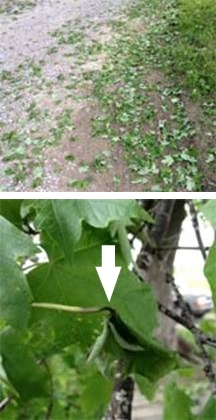Maple Petiole Borer
ENTFACT-405: Maple Petiole Borer | Download PDF
by Lee Townsend, Extension Entomologist
University of Kentucky College of Agriculture
From: "Urban Phytonarian Series" by D. L. Mahr, University of Wisconsin

Maple Petiole Borer: Signs & Symptoms
Symptoms
A sudden drop of many sugar maple leaves in May – June can be due to injury by a small wasp larva that burrows in leaf petioles. These stems usually break at a darkened area near the leaf blade. Usually, infestations are limited to sugar maples and only about 15% to 20% of the leaves fall to the ground.
While spectacular, the leaf drop has little effect on tree health. Buildups of scales or aphids, or drought stress can cause leaf loss but these typically occur later in the year.
Leaf drop due to borers occurs earlier in the season and the leaf blades may still be green. Leaves from trees stressed by sucking insects or drought usually have turned yellow before they drop. If the wasp is involved, splitting the petiole carefully near the leaf blade should reveal the larva or the tunnel.
Biology
Infestations begin as the adults, small wasps about 1/6" long, appear in May and lay their eggs in petioles near the leaf blades. Legless, white grubs with distinct light brown heads hatch from the eggs and tunnel inside the leaf stem for 20 to 30 days. The weakened stem breaks and the leaf floats to the ground.
The borer larvae remain in the portion of the stem left on the tree. About 10 days after leaf drop, the rest of the stem falls to the ground. The mature larva, about 1/3" long, leaves the stem through a hole in the side and burrows into the soil. It will change to the pupal stage and remain in the soil until the following spring.
The borer larvae remain in the portion of the stem left on the tree. About 10 days after leaf drop, the rest of the stem falls to the ground. The mature larva, about 1/3" long, leaves the stem through a hole in the side and burrows into the soil. It will change to the pupal stage and remain in the soil until the following spring. There is one generation each year.
Control
Maple petiole borer infestations are infrequent and unpredictable. Also, they do not appear to harm tree health so insecticidal control is not recommended. It may be possible to reduce future infestations somewhat by picking up and destroying infested stems, the short sections without leaves, about 7 to 10 days after the first leaves fall. This needs to be continued throughout the leaf drop period and must include all infested trees in the vicinity to be most successful. Raking and disposing of the fallen leaves will not reduce the population because the insects are not in that portion.
Minor revision: 05/13
CAUTION! Pesticide recommendations in this publication are registered for use in Kentucky, USA ONLY! The use of some products may not be legal in your state or country. Please check with your local county agent or regulatory official before using any pesticide mentioned in this publication.
Of course, ALWAYS READ AND FOLLOW LABEL DIRECTIONS FOR SAFE USE OF ANY PESTICIDE!
Images: University of Kentucky Entomology.
